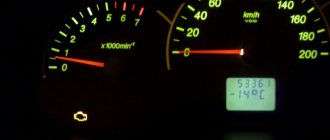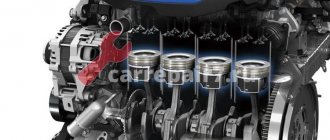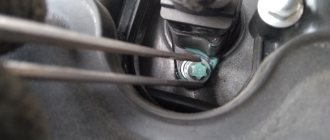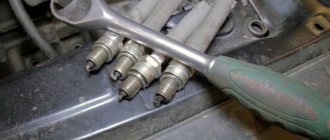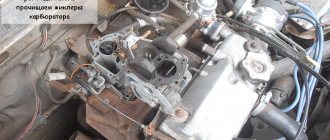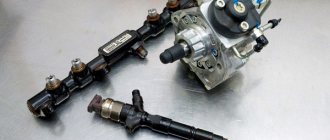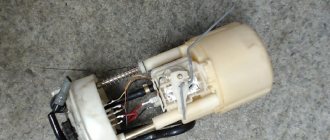Despite the huge amount of criticism against the Lada Priora, this is one of the most popular cars that have come out of the AvtoVAZ assembly line in recent years. The Priora is equipped with a fairly successful engine with good dynamics, and the interior is very comfortable. And the maximum trim levels offer useful options. But at the same time, from time to time the car brings minor problems to its owners. One of the most popular malfunctions is that the Priora engine (16 valves) is tripping. The reasons for this phenomenon are quite unpleasant. And besides, the motor eventually overheats.
When the driver starts his car in the morning, the engine does not run smoothly as before, but intermittently. At this time, dull sounds are heard from the exhaust pipe. At the same time, a persistent and strong smell of unburned fuel is felt. Vibrations are constantly increasing, and this is fraught with cracks in the pillows. This is how the engine runs when cold.
Trouble the engine: why is it dangerous?
This is a rather critical phenomenon, especially if the unit begins to vibrate during acceleration.
This behavior of the engine is especially dangerous when the driver decides to overtake, but there are cars in the oncoming lane. In the process, while the motor is running, the engine power is significantly reduced. The compression ratio decreases - there may not be enough dynamics to successfully complete the maneuver.
Considering that the Lada Priora has been manufactured since 2007, there are often instances where the engine knocks like on an old car 20 years ago. This is an engine running on three cylinders. It may have the latest firmware, but if the engine of a Lada Priora car is running rough and the check light is on, then such a car will not have much life left.
Supply system
If the Priora engine (16 valves) is tripping, the reasons may be trivial. When there is no flash in the cylinder, perhaps there is simply no fuel there. If it has a normal compression ratio, it is worth diagnosing the power system. You should pay maximum attention to the air filter and the pipe. It is necessary to make sure that the clamps are securely tightened, whether the purifier body itself is intact, and whether there is any air leakage from the outside. Also pay attention to the tubes. They must be tightly secured to the throttle assembly. Fuel leaks, cracks, and broken plastic may indicate that some parts are faulty.
Why does the “check” light up: the most common and common malfunctions
So, we figured out the general scheme. Now let's look at what problems lead to the check light coming on and the engine stalling. Often a p0300 error occurs, which indicates that a misfire (misfire) is occurring. There are several reasons for these omissions, and to determine them it is necessary to carry out a step-by-step diagnosis, taking into account certain individual symptoms.
- You should start by checking the ignition system. The most common cause of tripping is the failure of spark plugs and armored wires. Candles can wear out their service life, break down, or become heavily contaminated. Armored wires suffer from insulation damage and breakdowns. One way or another, the result is either no spark at all, or there is a spark, but it’s weak.
If everything is in order with the spark plugs and wires, you should pay attention to the ignition module or ignition coils, which may be shorting. In this case, it is better to entrust the check to experienced specialists, since unprofessional actions lead to the fact that you can burn the switch or damage other important elements.
It should also be added that you need to carefully inspect the spark plug wells themselves. Quite often, the engine fails if water accumulates in the wells or engine oil gets there. In some cases, lubricant gets into the wells due to problems with the valve cover gasket.
- Having dealt with the ignition system, it is necessary to check the power system. As a rule, incorrect operation of injection nozzles or malfunctions in their operation lead to engine tripping. At the same time, the check will light up or flash.
We also recommend reading the article about what misfires in engine cylinders are. In this article, you will learn about the causes of misfires and errors, as well as how to identify and fix the problem.
The best option would be to check the injectors on a special stand. Such diagnostics allows you to determine the need to clean, repair or replace injectors. At the same time, specialists check the power supply to the injectors, the condition of the injector O-rings, etc.
- As for compression, a burnt-out valve often leads to an unexpected decrease in the indicator. If the valve burns out, the engine starts to run rough. In this case, tripling is constant and occurs in all modes of engine operation. Engine thrust drops significantly, and significant excess fuel consumption is observed.
Please note that in this case you cannot drive the car, as there is a high risk of damaging the catalyst and oxygen sensor (lybda probe). To confirm the diagnosis, you need to measure the compression, and to solve the problem itself, you need to remove the cylinder head, troubleshoot the head and change the valve.
Nozzle failures, clogging
When the Priora engine (16 valves) fails, the reasons often lie in the injector.
It may be faulty or simply blocked. Beginners and those who like to pour various injector cleaning fluids into the tank often encounter this problem. All this leads to the fact that the dirt first peels off in the tank, then in the fuel line. And eventually it will end up in the injectors, where it will happily get stuck.
Poor quality fuel
This is one of the possible reasons why the engine stalls at idle or while driving.
To return to normal operation, you can try changing the gas station. This usually helps clear up a lot of misunderstandings. It is better to fill the 16-valve Priora engine with good 95-octane gasoline. It's not worth pouring something with a higher octane number. This will only lead to overheating. You can also try replacing the air and fuel filters. Sometimes this solves the problem.
Engine diagnostics
Why does the Lada Priora engine stall? Before proceeding with the analysis of the mechanical part of the fault, many owners and mechanics recommend conducting computer diagnostics of the car. Maybe you really shouldn’t go into the mechanical part and look for faults there, but just look at what the electronic engine control unit shows in this case.
So, for computer engine diagnostics you will need a vehicle connection cable (OBD II), a laptop or tablet, and the appropriate software.
Having connected and synchronized with the car, we diagnose the condition of the engine, and also analyze the errors that it generated. Based on this information, you can understand whether all sensors are working properly, and whether there are problems in the software.
The next step is to check the engine sensors using a tester. They are diagnosed by ringing the contacts to see if they are working in the on-board network and if there is an impulse that goes to the ECU. So, what sensors need to be checked:
- Coolant temperature sensor.
- Mass air flow sensor.
- Idle speed regulator.
- Knock sensor.
- Crankshaft position sensor.
If any of these meters fails, it must be replaced. After this, it is recommended to reset all errors that were detected in the control unit. The electronic procedure is completed.
Ignition system
An experienced car enthusiast who is faced with an engine running on three cylinders immediately begins to diagnose the spark plugs. The Lada Priora must cool well, otherwise there is a risk of getting burned when unscrewing it. If after a few seconds you turn off the ignition and check the spark plugs, one of them will be wet with gasoline. It is also recommended to separately check each part for the presence of a spark.
In case of malfunction, the problem is solved by replacing the spark plug. Sometimes it is enough to press down a potentially faulty one with a cap and the machine will resume normal operation. In general, the ignition system in this car is the most problematic part. If the Priora engine (16 valves) is malfunctioning, you can look for the reasons for a very long time, and diagnostics will not yield anything, even if it is done correctly. And only by replacing all elements can a positive result be achieved.
Causes and Effects
The reasons why the Priora 16 valve engine is tripping can be very diverse. Several systems are involved in the normal operation of the engine. Therefore, to identify the source of the problem, it is necessary to check the following systems:
- Supply system;
- Ignition;
- Sensors
Very often, it is on Priors with a 16-valve engine that the problem arises due to power problems. Therefore, you need to check it first.
The consequences of engine tripping can be the most unpleasant. Outwardly, this manifests itself as hassle. After all, the engine is unstable and shaking. Often the interior begins to smell of gasoline. Don't forget the money issue. The car noticeably increases its appetite and you have to visit the gas station much more often. It's much worse that it leads to more serious damage.
First, the fuel settles on the cylinder walls and seeps into the block, mixing with the oil there. Due to this, the lubrication of the unit deteriorates, and parts wear out faster. It is also possible for a water hammer to form if a sufficient amount of fuel accumulates in the cylinder. In the simplest case, the remaining working cylinders bear a large load. As a result, their elements fail earlier. In any case, it is necessary to eliminate this problem in a timely manner.
Before you begin more specific troubleshooting, perform diagnostics using a laptop. This will help you determine which cylinder is not firing. Typically, such errors are recorded in the memory of the engine control unit. Having determined where the flash skip occurs, start working.
Diagnostics of spark plugs by plaque
When the engine starts cold or hot, you can check the carbon deposits on the spark plugs. If the coating is white, then this indicates a lean mixture and overheating of the engine. A black tint indicates a rich mixture. In both the first and second cases there are problems with the operation of the electronics. This is either installing new firmware, or replacing the ECU. A normal candle has a brick color. By the way, the engine may stall at idle if the part is damp. This also significantly increases the warm-up time. In addition to the spark plugs, the ignition coil may also be acting up. Priora (8 valves) is equipped with distributor ignition. Overheating of the coil is often observed. You can restore the operation of the motor by simply replacing the element.
Troubles the engine
Cars January 28, 2017
Despite the huge amount of criticism against the Lada Priora, this is one of the most popular cars that have come out of the AvtoVAZ assembly line in recent years. The Priora is equipped with a fairly successful engine with good dynamics, and the interior is very comfortable.
And the maximum trim levels offer useful options. But at the same time, from time to time the car brings minor problems to its owners. One of the most popular malfunctions is that the Priora engine (16 valves) is tripping. The reasons for this phenomenon are quite unpleasant.
And besides, the motor eventually overheats.
When the driver starts his car in the morning, the engine does not run smoothly as before, but intermittently. At this time, dull sounds are heard from the exhaust pipe. At the same time, a persistent and strong smell of unburned fuel is felt. Vibrations are constantly increasing, and this is fraught with cracks in the pillows. This is how the engine runs when cold.
Trouble the engine: why is it dangerous?
Considering that the Lada Priora has been manufactured since 2007, there are often instances where the engine knocks like on an old car 20 years ago. This is an engine running on three cylinders. It may have the latest firmware, but if the engine of a Lada Priora car is running rough and the check light is on, then such a car will not have much life left.
Supply system
If the Priora engine (16 valves) is tripping, the reasons may be trivial. When there is no flash in the cylinder, perhaps there is simply no fuel there. If it has a normal compression ratio, it is worth diagnosing the power system. You should pay maximum attention to the air filter and the pipe.
It is necessary to make sure that the clamps are securely tightened, whether the purifier body itself is intact, and whether there is any air leakage from the outside
Also pay attention to the tubes. They must be tightly secured to the throttle assembly
Fuel leaks, cracks, and broken plastic may indicate that some parts are faulty.
When the Priora engine (16 valves) fails, the reasons often lie in the injector.
Injector winding
It can not only become clogged with dirt - often the windings of the elements burn out on Priors. In this case, the situation can be easily restored with your own hands. The cover is removed, and then the manifold. Next, the injector windings are checked. Using a multimeter, measure the resistance of the windings. It should be around 11-15 ohms. If the indicators are lower, the element should be replaced.
How to troubleshoot injector problems?
If the resistance is normal, then it is recommended to completely dismantle the fuel rail and thoroughly wash each part. You should not perform this operation if you have no experience in this work. To flush, the nozzle valves must be opened. Then apply aerosol washing there under pressure. It's not difficult, but without experience you can ruin everything.
Diagnostics of spark plugs by plaque
When the engine starts cold or hot, you can check the carbon deposits on the spark plugs. If the coating is white, then this indicates a lean mixture and overheating of the engine. A black tint indicates a rich mixture. In both the first and second cases there are problems with the operation of the electronics. This is either installing new firmware, or replacing the ECU.
A normal candle has a brick color. By the way, the engine may stall at idle if the part is damp. This also significantly increases the warm-up time. In addition to the spark plugs, the ignition coil may also be acting up. Priora (8 valves) is equipped with distributor ignition. Overheating of the coil is often observed.
You can restore the operation of the motor by simply replacing the element.
Summary
So, we looked at why the car is tripping. These are not all possible reasons, but they help to accurately diagnose the operation of the motor and find the malfunction.
Checking the ignition coil
There is simply no special method by which you can check the operation of parts. The instructions for the car indicate one of the methods for self-diagnosis. So, with the ignition turned off, check whether the ignition coil (Priora is no exception) is firmly attached to the engine.
Then they look at the reliability of electrical connections in the low-voltage circuit. If everything is in order, then check for a spark. To do this, the ignition coil is removed. A test plug is inserted into the tip and pressed against a metal part of the engine. Next, turn the starter. If there is no spark, replace the coil. If there is a flash, but the engine does not start, change the spark plug.
Description of the ignition coil
Let's start with a description of automotive short circuits. First of all, it is necessary to consider the device, as well as the operating principle of the unit on an engine with 8 or 16 valves.
Design and principle of operation
Every car enthusiast knows that the main function of the short circuit on the Lada Priora is to ignite the combustible mixture, which is necessary to start the power unit. To ensure the mixture is ignited, a very high voltage is generated in the short circuit, amounting to 40 thousand volts. The short circuit itself is a transformer device designed to increase the low voltage produced by the battery. According to its design, the short circuit of a 16-valve engine consists of two windings - primary and secondary, which are wound using a copper wire on a steel core.
First, the primary device is wound onto the core, and the secondary device is wound on top of it. This design is protected by a special housing. If the primary winding contains about 150 turns, then the secondary winding will have more than one thousand of them. There are no high-voltage cables in the short-circuit design, since they are put on the spark plug.
When the powertrain control unit transmits a signal to the primary winding, a magnetic field is generated around the core. Ultimately, it contributes to the formation of high voltage on the secondary winding. As for the spark plug, at this moment it ignites the combustible mixture in the cylinders of a 16-valve engine. The short circuit is equipped with a protective housing, and inside the structure there is a special spring with a diode. The latter is designed for promptly cutting off high-voltage signals (the author of the video about the node malfunction is the IZO)))LENTA channel).
Types of coils
Let's briefly consider the main types of short circuits for cars:
- General short circuit, this type is one of the most common. It can be used in both contact and non-contact systems, as well as electronic systems with a distributor.
- Individual type of short circuit. Designed for use in electronic systems. By design, this type also consists of primary and secondary windings, only they are located in reverse - first the secondary, then the primary. Also, such short circuits can use electronic components to ignite a combustible mixture.
- Dual type, such short circuits are also often called two-terminal. Such units are used in various electronic systems. The key difference in the design is the presence of two high-voltage cables, designed to ensure the formation of a spark in two cylinders simultaneously.
Symptoms of a problem
The ignition coil on a Priora on a 16-valve engine, like any other mechanism, sooner or later fails.
The driver can recognize that this device needs replacement or repair by the following symptoms:
- The operation of the power unit as a whole is disrupted. The 16-valve engine begins to vibrate, its power drops, and when you press the gas pedal it will be difficult to accelerate. In addition, the engine begins to stall. The same signs also appear with inoperative spark plugs, so they need to be checked first.
- While trying to accelerate, the driver will notice that the vehicle begins to jerk. Shocks also appear when driving at low speeds.
- Another symptom is the presence of cracks or traces of breaks in the insulation.


